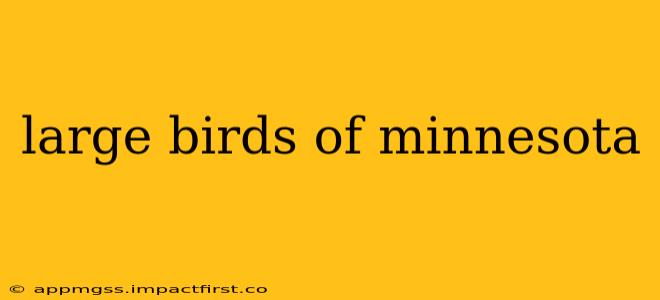Minnesota, with its diverse landscapes ranging from prairies and forests to lakes and wetlands, provides a haven for a variety of bird species, including some impressively large ones. Identifying these majestic creatures can add a thrilling dimension to your outdoor adventures. This guide explores some of the largest birds you might encounter in the Gopher State, addressing common questions bird enthusiasts often have.
What are some of the biggest birds in Minnesota?
Several large bird species call Minnesota home, either year-round or as seasonal visitors. Among the most notable are:
-
Wild Turkey (Meleagris gallopavo): These iconic birds are relatively common throughout Minnesota, boasting impressive size, particularly the males (toms). They can weigh up to 24 pounds and have a wingspan exceeding four feet.
-
Great Blue Heron (Ardea herodias): A stately wading bird, the Great Blue Heron is easily recognizable by its size and striking blue-gray plumage. They can reach heights of up to 50 inches and have a wingspan approaching 7 feet. They're often found near lakes, rivers, and marshes.
-
Sandhill Crane (Antigone canadensis): These tall, graceful birds are known for their distinctive calls. They stand about 4 feet tall and have a wingspan of around 6 feet. Sandhill Cranes are migratory, spending their winters in the southern United States and returning to Minnesota for breeding season.
-
Bald Eagle (Haliaeetus leucocephalus): The national bird of the United States, the Bald Eagle is a powerful predator with a massive wingspan that can exceed 7 feet. While their numbers have significantly rebounded, they remain a magnificent sight.
-
Whooping Crane (Grus americana): While extremely rare in Minnesota, the Whooping Crane is the tallest bird in North America, standing over 5 feet tall with a wingspan over 7 feet. Sightings are highly unusual and should be reported to wildlife officials.
What is the largest bird of prey in Minnesota?
The Bald Eagle is generally considered the largest bird of prey in Minnesota. Its size, power, and hunting prowess make it a top predator in its environment. While other raptors like the Great Horned Owl are large and powerful, the Bald Eagle's wingspan and overall bulk give it the edge in terms of sheer size.
What is the largest waterfowl in Minnesota?
While several waterfowl species inhabit Minnesota, the Trumpeter Swan (Cygnus buccinator) holds the title of the largest. These majestic birds possess an impressive wingspan of up to 8 feet and can weigh over 25 pounds. Their elegant form and powerful flight are captivating to observe.
Where can I see large birds in Minnesota?
The best places to spot large birds in Minnesota depend on the species you're hoping to see. National wildlife refuges, state parks, and areas with significant wetlands and forests offer the best chances. Consider visiting areas such as:
- Sherburne National Wildlife Refuge: Excellent for viewing waterfowl and wading birds.
- Lake Superior shoreline: Potential for observing Bald Eagles and other raptors.
- Rice Lake National Wildlife Refuge: Another prime location for waterfowl viewing.
- Various state parks: Many state parks throughout Minnesota provide habitat for a variety of bird species.
Remember to always observe wildlife from a safe and respectful distance, using binoculars for optimal viewing.
What time of year is best for birdwatching in Minnesota?
Spring and fall migration periods are ideal times for birdwatching in Minnesota, as numerous species pass through the state. However, depending on the species you are interested in, you might find better viewing opportunities during the breeding season (spring/summer) or wintering periods (winter).
This guide offers a starting point for exploring the fascinating world of large birds in Minnesota. Further research into specific species will enhance your birding adventures and deepen your appreciation for these magnificent creatures. Remember to always practice responsible wildlife viewing and respect the natural habitats these birds call home.
